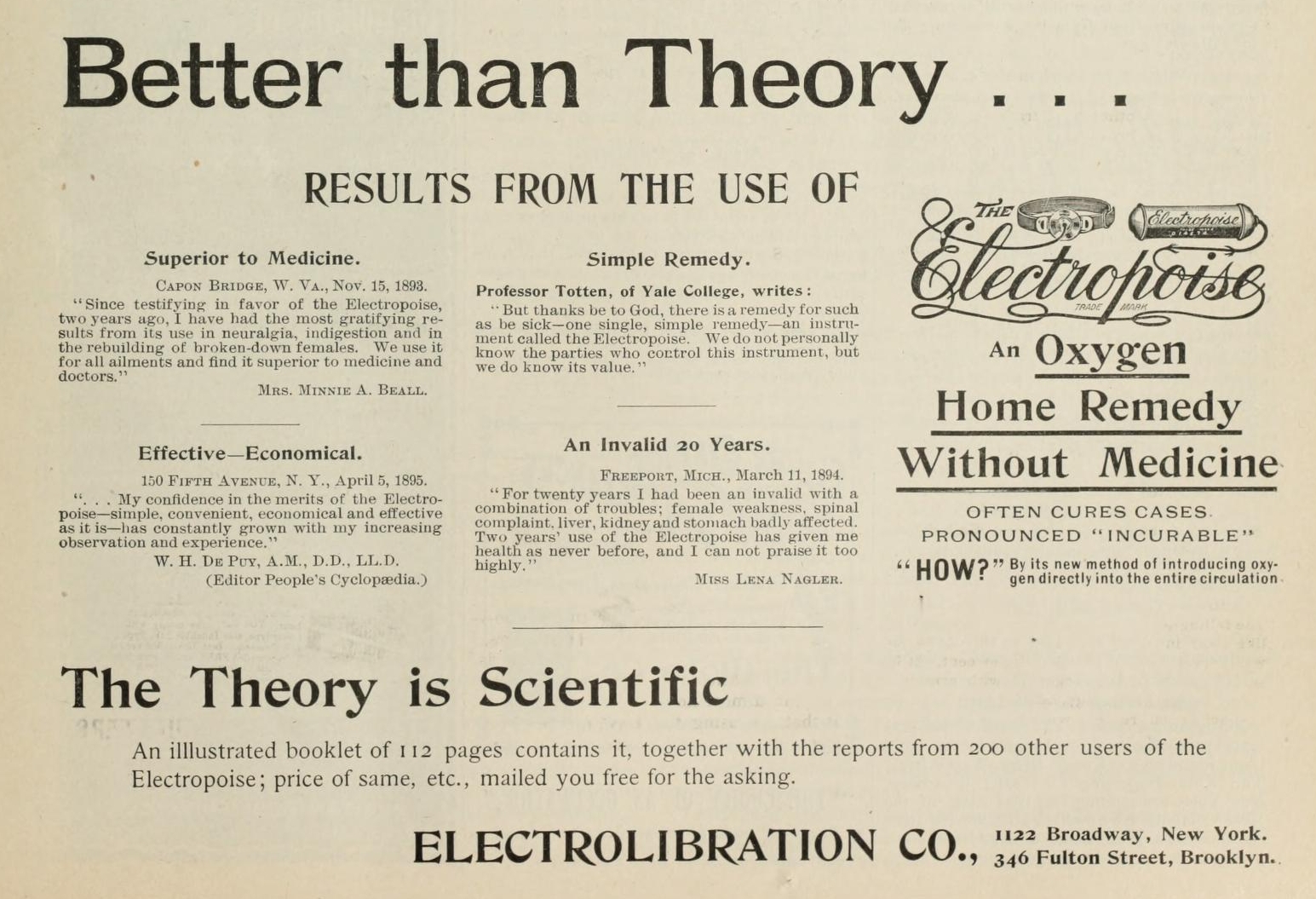Hercules Sanche on:
[Wikipedia]
[Google]
[Amazon]
 The Electropoise was a fake
The Electropoise was a fake
''Nostrums and Quackery: Articles on the Nostrum Evil and Quackery''
Press of American Medical Association. *
Museum of Electrotherapy
Electrotherapy Health fraud products Pseudoscience
 The Electropoise was a fake
The Electropoise was a fake medical instrument
A medical device is any device intended to be used for medical purposes. Significant potential for hazards are inherent when using a device for medical purposes and thus medical devices must be proved safe and effective with reasonable assura ...
patented and sold in the United States of America by Hercules Sanche, who also invented and sold other fake instruments which were later termed as "electroquackery" and included such devices as the "Oxydonor" which were claimed to remedy a range of ailments.
History
The instruments were widely advertised in popular magazines and the company, Electrolibration, opened numerous offices far from their headquarters inBirmingham, Alabama
Birmingham ( ) is a city in the north central region of the U.S. state of Alabama. Birmingham is the seat of Jefferson County, Alabama's most populous county. As of the 2021 census estimates, Birmingham had a population of 197,575, down 1% fr ...
including New York and London. The President of Electropoise, John N. Webb, admitting that he was not a man of science stated that his hands were full handling the business. It was sold for about twenty-five dollars. Other successors like Oxydonor were sold at ten to thirty dollars. Even during its heyday, a period when electricity was viewed with awe, some physicians called attention to the nature of the fraud but their efforts had little impact on the advertisement and sale. A letter to the editor of the ''Journal of the American Medical Association
''The Journal of the American Medical Association'' (''JAMA'') is a peer-reviewed medical journal published 48 times a year by the American Medical Association. It publishes original research, reviews, and editorials covering all aspects of bio ...
'' in 1897 by a physician named George N. Kreider states that "One of the most glaring frauds of this decade has been an appliance known as 'Electropoise,' advertised in Harper's Monthly and other leading publications" and promoted by a W.H. De Puy, editor of the New York Christian Advocate.
N.C. Morse, a physician, tried investigating the instrument and wrote: ''I have had it sawed into sections and alas, like the goose that laid the golden egg of fable fame, there is nothing in the carcass!'' Another physician named Harding wrote in 1930 that the pricing of such devices helped in selling the remedy which may have had a placebo
A placebo ( ) is a substance or treatment which is designed to have no therapeutic value. Common placebos include inert tablets (like sugar pills), inert injections (like Saline (medicine), saline), sham surgery, and other procedures.
In general ...
effect. The advertisement was clever in claiming that it enhanced the body's natural healing ability. The Electropoise, it claimed:
Elsewhere it claimed:
Skeptics pointed out the fraudulent logic used in claims and endorsements of its curative effect stating that it was dangerous use of ''post hoc ergo propter hoc'' as the logic.
Sanche was careful in that he never claimed that his device would cure diseases like tuberculosis. Others like E.L. Moses, inventor of Oxypathor, would go to jail for 18 months in 1915 for making false curative claims.
The company was not without competition. A device called the Oxygenor was marketed by a rival and Sanche went to court. The court claimed that there was not enough evidence for the value of his invention and therefore that it could not be protected. Justice Shiras and the other judges declared that his theory of "diaduction" (a term he coined) was a mere pretense to allow him to obtain a patent. In Britain the Richardson Electro-Galvanic Belt of Ludgate Hill and the Magneto-Electric Battery Company were competing with Electropoise.
See also
*Pulvermacher's chain
The Pulvermacher chain, or in full as it was sold the Pulvermacher hydro-electric chain, was a type of voltaic battery sold in the second half of the 19th century for medical applications. Its chief market was amongst the numerous quack practit ...
* Radionics
Radionics—also called electromagnetic therapy (EMT) and the Abrams Method—is a form of alternative medicine that claims that disease can be diagnosed and treated by applying electromagnetic radiation (EMR), such as radio waves, to the bo ...
References
{{reflistFurther reading
*American Medical Association
The American Medical Association (AMA) is a professional association and lobbying group of physicians and medical students. Founded in 1847, it is headquartered in Chicago, Illinois. Membership was approximately 240,000 in 2016.
The AMA's state ...
. (1911)''Nostrums and Quackery: Articles on the Nostrum Evil and Quackery''
Press of American Medical Association. *
Stewart Holbrook
Stewart Hall Holbrook (1893–1964) was an American logger, writer, and popular historian. His writings focused on what he called the "Far Corner": Washington, Oregon, and Idaho. A self-proclaimed "low-brow" historian, his topics included Ethan ...
. (1959). ''The Golden Age of Quackery''. Collier Books.
External links
Museum of Electrotherapy
Electrotherapy Health fraud products Pseudoscience